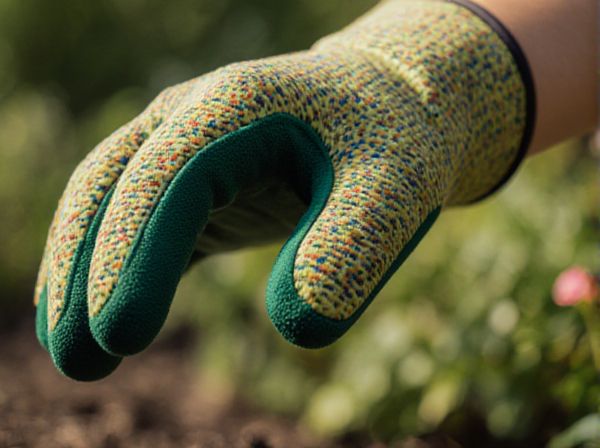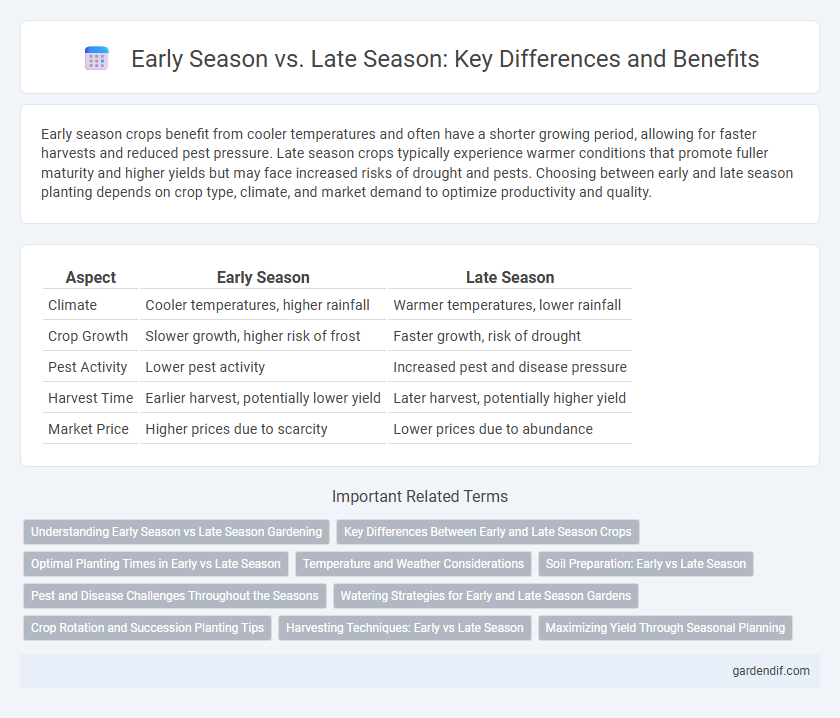
Early season vs Late season Illustration
Early season crops benefit from cooler temperatures and often have a shorter growing period, allowing for faster harvests and reduced pest pressure. Late season crops typically experience warmer conditions that promote fuller maturity and higher yields but may face increased risks of drought and pests. Choosing between early and late season planting depends on crop type, climate, and market demand to optimize productivity and quality.
Table of Comparison
| Aspect | Early Season | Late Season |
|---|---|---|
| Climate | Cooler temperatures, higher rainfall | Warmer temperatures, lower rainfall |
| Crop Growth | Slower growth, higher risk of frost | Faster growth, risk of drought |
| Pest Activity | Lower pest activity | Increased pest and disease pressure |
| Harvest Time | Earlier harvest, potentially lower yield | Later harvest, potentially higher yield |
| Market Price | Higher prices due to scarcity | Lower prices due to abundance |
Understanding Early Season vs Late Season Gardening
Early season gardening involves planting crops like peas, spinach, and radishes that thrive in cooler temperatures and shorter daylight hours, maximizing growth before the heat of summer arrives. Late season gardening focuses on heat-tolerant crops such as tomatoes, peppers, and eggplants, which require longer growing periods and warmer soil conditions to produce optimal yields. Understanding soil temperature, frost dates, and daylight duration is crucial for selecting the right crops and scheduling planting times effectively in both early and late season gardening.
Key Differences Between Early and Late Season Crops
Early season crops thrive in cooler temperatures and shorter daylight hours, allowing for faster germination and growth, whereas late season crops require warmer soil and longer daylight to reach maturity. Pest and disease pressure tends to be lower in early season plantings, while late season crops often face increased risks due to prolonged exposure. Yield and quality can differ significantly, with early season crops offering quick harvests but sometimes smaller size, and late season crops typically achieving larger, more robust produce due to extended growing periods.
Optimal Planting Times in Early vs Late Season
Optimal planting times in early season typically range from late March to mid-April, allowing crops to establish before the peak growing temperatures arrive. Late season planting, generally occurring from late July to early September, benefits heat-tolerant varieties and extends harvest periods into cooler months. Understanding soil temperature thresholds, such as 50degF (10degC) for seed germination in many vegetables, is crucial to maximize growth and yield in both early and late planting windows.
Temperature and Weather Considerations
Early season typically features cooler temperatures and unpredictable weather, requiring crops and activities to withstand possible frost and variable rainfall. Late season benefits from warmer temperatures and more stable weather patterns, reducing the risk of cold damage but increasing exposure to heat stress and drought conditions. Choosing the appropriate timing depends on understanding temperature fluctuations and weather trends specific to the region's climate.
Soil Preparation: Early vs Late Season
Early season soil preparation involves thorough tilling and incorporation of organic matter to ensure warmth and moisture retention for seed germination, optimizing root development at cooler temperatures. Late season soil preparation prioritizes soil aeration and restructuring to improve drainage and prevent compaction from previous crop residues, facilitating nutrient accessibility for late-planted crops. Both approaches require precise timing of soil amendments like lime or fertilizer based on soil testing to match the specific crop growth stage and seasonal climatic variations.
Pest and Disease Challenges Throughout the Seasons
Early season crops face heightened risks from fungal diseases due to cooler, wetter conditions that favor pathogen development, while pest infestations tend to be lower but can still impact young plants. Late season challenges often include increased pressure from insect pests attracted by mature crops and intensified fungal infections caused by humidity and temperature fluctuations. Effective integrated pest management strategies must adapt to these seasonal variations to minimize crop loss and ensure sustainable yields.
Watering Strategies for Early and Late Season Gardens
Watering strategies for early season gardens emphasize consistent moisture to support young plants' root development and prevent stress during cooler, less humid conditions. In late season gardens, watering should adapt to decreased plant growth rates and potential heat stress by reducing frequency but increasing depth to encourage resilient root systems. Efficient irrigation management tailored to seasonal plant needs optimizes water use and promotes healthy garden productivity throughout the year.
Crop Rotation and Succession Planting Tips
Early season crop rotation enhances soil fertility by incorporating nitrogen-fixing legumes before planting heavy feeders, reducing pest buildup and improving overall yield. Late season succession planting optimizes garden space by quickly replacing harvested crops with fast-maturing varieties, ensuring continuous production until frost. Strategic timing in rotation and succession planting minimizes disease risk and maximizes nutrient use efficiency across different seasonal phases.
Harvesting Techniques: Early vs Late Season
Early season harvesting techniques prioritize rapid picking to preserve the freshness and firmness of fruits and vegetables, often using hand harvesting to minimize damage. Late season harvesting requires more careful timing to capture peak ripeness while employing mechanical methods suited for larger, mature crops, balancing efficiency with quality retention. Both approaches tailor post-harvest handling practices to optimize shelf life and reduce spoilage based on the crop's developmental stage.
Maximizing Yield Through Seasonal Planning
Maximizing agricultural yield requires strategic planning around early season and late season planting schedules. Early season crops benefit from cooler temperatures and early sunlight, promoting robust growth, while late season planting capitalizes on extended daylight and warmer conditions to enhance fruit maturation. Understanding crop-specific temperature tolerances and frost dates enables farmers to optimize planting windows, reduce pest pressures, and extend harvest periods for increased overall productivity.
Early season vs Late season Infographic

 gardendif.com
gardendif.com